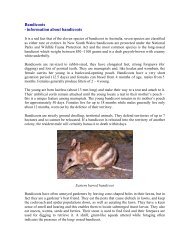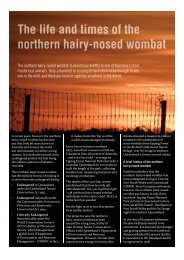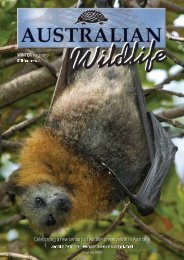Wildlife Preservation Autumn 2012.indd - Wildlife Protection Society ...
Wildlife Preservation Autumn 2012.indd - Wildlife Protection Society ...
Wildlife Preservation Autumn 2012.indd - Wildlife Protection Society ...
Create successful ePaper yourself
Turn your PDF publications into a flip-book with our unique Google optimized e-Paper software.
The echidna<br />
Andrea Devos - www.taswildliferescue.com.au<br />
The echidna is an extremely secretive<br />
animal, and it is extremely sensitive<br />
to vibrations on the ground. Echidnas<br />
have a domed-shaped back with short<br />
stubby tail, no obvious neck, and a at<br />
belly. Back and sides are covered with<br />
spines of varying sizes and lengths.<br />
The echidna is easily recognisable<br />
by the covering of spines across its<br />
body which is a safety mechanism for<br />
the animal. These spines are yellow<br />
to golden with a black to brown tip.<br />
Between the spines is soft hair, longer in<br />
cooler climates and shorter in warmer<br />
areas. (In Tasmania the fur sometimes<br />
obscures the spines.) Echidnas have<br />
ve toes on both the front and hind<br />
limbs, on the hind limbs they have two<br />
to three grooming claws (depending on<br />
the species). The pads of the front feet<br />
are full and rm in healthy animals.<br />
They contain mechanoreceptors that<br />
pick up vibrations from crunching feet,<br />
breaking vegetation and probably food<br />
sources.<br />
The echidna’s snout is between seven<br />
and eight centimetres long and is<br />
sti ened to enable the animal to<br />
break up logs and termite mounds<br />
when searching for food. They are key<br />
cultivators that enhance soil aeration,<br />
moisture penetration, nutrient<br />
mixing, seed dispersal and spread of<br />
mycorrhizae. Adult echidnas vary in<br />
size from 30-53 centimetres, with males<br />
weighing six kilograms and females 4.5<br />
kilograms. Echidnas can live for more<br />
than 50 years.<br />
Australian <strong>Wildlife</strong> Vol 2 - <strong>Autumn</strong> 2012<br />
You cannot sex an echidna simply<br />
by looking at the animal. There are<br />
no external genitals. Both males and<br />
females can form a pouch. Both males<br />
and females can retain or lose the<br />
spur on the hind foot. Size and weight<br />
of an animal is not an indication of<br />
gender. The male echidna does not use<br />
the penis for urination. It is located<br />
internally and is only outside of the<br />
body when used for copulation. Until<br />
a male echidna has reached sexual<br />
maturity, it can be extremely di cult<br />
to nd evidence of the penis. However,<br />
it is not impossible because a mature<br />
echidna can be palpated, especially<br />
during the courtship and breeding<br />
season.<br />
The echidna has small external eyes,<br />
but sense of sight is highly developed.<br />
They quickly recognise human shape<br />
so it is best to sit or kneel in order to<br />
break up the normal towering human<br />
silhouette.<br />
When threatened, the echidna can dig<br />
very quickly and bury itself in the soil,<br />
or curl into a tight ball with its snout<br />
and legs tucked beneath it and raise<br />
its spines or quills so that it cannot<br />
be handled easily. The echidna can<br />
be found throughout all of Australia<br />
wherever there are ants or termites<br />
present, as this is its main diet source.<br />
The echidna has no teeth, but a very<br />
long tongue, which extends into<br />
ant mounds. Its tongue is around 18<br />
centimetres long and coated with a<br />
sticky saliva substance which the ants<br />
stick to. Dirt and ant nest material is<br />
also ingested.<br />
The echidna is a solitary animal, not<br />
territorial, but occupying overlapping<br />
ranges. Its home range can be in excess<br />
of 250 hectares, depending on food<br />
availability and habitat. Echidnas do not<br />
The taxonomic family name for echidna – Tachyglossidae – means “fast tongue”<br />
37





